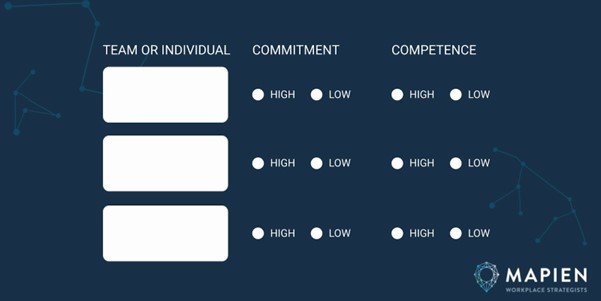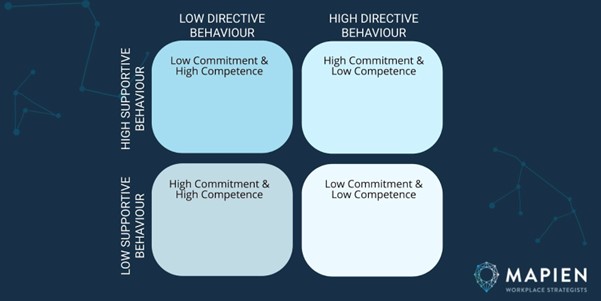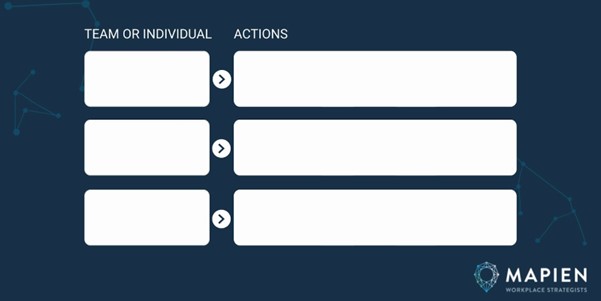
Using the Situational Leadership Model to Lead With Flexibility
This is blog #5 in our series on coaching models. Sign up to our mailing list to make sure you don’t miss out on our future content.
Do you consider yourself a flexible leader? Or want to become more flexible and responsive to the situation or the individuals you’re in charge of?
Good leadership doesn’t require ‘the best’ leadership style — there’s no such thing. In some situations, good leadership looks like coaching or supporting, while in other situations, a good leader will need to delegate or even direct people on what to do.
The best leadership style will always depend on the situation, and the most effective leaders are those that can quickly adapt their approach.
Some leaders do this quite naturally — with the social intelligence to respond to changing environments and situations around them. But many also benefit from a methodical approach that helps them analyse situations and understand when to apply different leadership styles. And that’s where the Situational Leadership Model comes in.
What is the Situational Leadership Model?

The Situational Leadership Model is based on a theory developed by Dr. Paul Hersey and Dr. Ken Blanchard, as part of their textbook, Management of Organizational Behavior (1969).
The model is designed to help leaders identify the most beneficial leadership style (with an appropriate level of support and direction), based on a careful consideration of a team or individual’s competence and confidence with a task or situation. In summary, it:
- Defines four overarching leadership styles
- Classifies four levels of follower readiness
- Allows for a quick analysis of the situation
- Points towards the most appropriate leadership approach
The idea is that there’s no perfect leadership style, but that effective leaders should adapt and respond to the task or situation at hand, and the individual or group that they need to influence.
So, let’s break down the different components of the model…
Levels of Follower Readiness
Follower readiness levels range from low to high, depending on the person or group’s level of knowledge, skills, willingness, or confidence.
1. LOW: Unable/ Insecure/ Unwilling: Limited knowledge, skills, willingness, and/or confidence to work on their own.
2. MEDIUM: Unable/ Confident/ Willing: Willing to do the task, but limited skills to complete it.
3. MEDIUM: Able/ Insecure/ Unwilling: Able to do the task, but either insecure or unwilling to complete it.
4. HIGH: Able/ Confident/ Willing: Able, confident, and willing to do the task successfully and take responsibility for it.
It’s important to be aware that follower readiness will change, depending on the situation — from moment to moment and from one task to another.
Situational Leadership Styles
You may need to switch between each of the following leadership styles, depending on the situation that comes up — and the teams and individuals you need to manage.
High Task/Low Relationship: Directing or Telling
When team members are inexperienced and/or they lack commitment to a specific task, you’ll likely need to take a more directional style of leadership. This involves providing specific instructions, telling team members what to do and how to do it, and closely supervising performance.
High Task/High Relationship: Coaching or Selling
When team members are interested or enthusiastic about a task but lack the necessary skills, you can apply a coaching or guiding leadership style. You would provide directions, explain your decisions, and give opportunities for clarification. This approach includes more two-way communication and socio-emotional support, and should lead to more buy-in from team members.
Low Task/High Relationship: Supporting or Participating
When team members have the skills they need to complete a task but lack confidence or motivation, a supporting or participating leadership style can be helpful. This involves providing less clear direction to team members, but working closely with them to share ideas, solve problems, and facilitate making decisions.
Low Task/Low Relationship: Delegating
When team members have the skills, confidence, and motivation to complete a task, delegation is the most appropriate leadership style. This is considered a more passive, hands-off approach. It involves deferring most of the responsibility for decisions and implementation to the team, and instead monitoring their progress.
Three Steps to Apply the Situational Leadership Model
You can print or recreate the following worksheets to go through the process and fill out your own Situational Leadership Model.
1: Reflection

Start by reflecting on the team or person you are leading within a given context. Consider their overall level of commitment and competence in the situation — as this will dictate your leadership style.
2: Matrix

Use the matrix to plot the location of each team or person identified in step 1, based on their level of commitment and competence. Then refer to the labels on each axis to identify the level of direction and socio-emotional support you may need to provide as a leader.
3: Actions

Finally, based on the leadership styles you identified in step 2, note down some actions you can take that will support the performance of each team or individual.
For example, you might decide to take a more hands-on approach with one team, and work alongside another team. You might take more of a coaching role with one of your employees that needs some direction, but then delegate a specific task to another individual that’s ready to take responsibility for it.
Get Started with Flexible Leadership
“An effective leader is a flexible leader.”
Flexibility is key to effective leadership — not only to keep up with the pace of change in business, but to ensure you can respond to the changing situations and needs of the people around you.
After all, if your leadership style does not match your team’s readiness for the task, there’s likely to be a disconnect. A hands-off approach with a team that’s not equipped for the task is a recipe for disaster. And telling your most experienced employees what to do and how to do their job would be equally unwise.
That said, the Situational Leadership Model is really just a starting point for determining your behaviour as a leader. Successful leadership requires many other components, such as listening, communicating, and feedback. There are also many other coaching models that can be valuable for leaders — some of which we’ve already covered in this series:
Connect with us!
We’ll be back with more leadership and coaching models soon, as we continue this series. In the meantime, if you’d like more personalised support with leadership coaching or more tools like this one, start the conversation with our team today.

